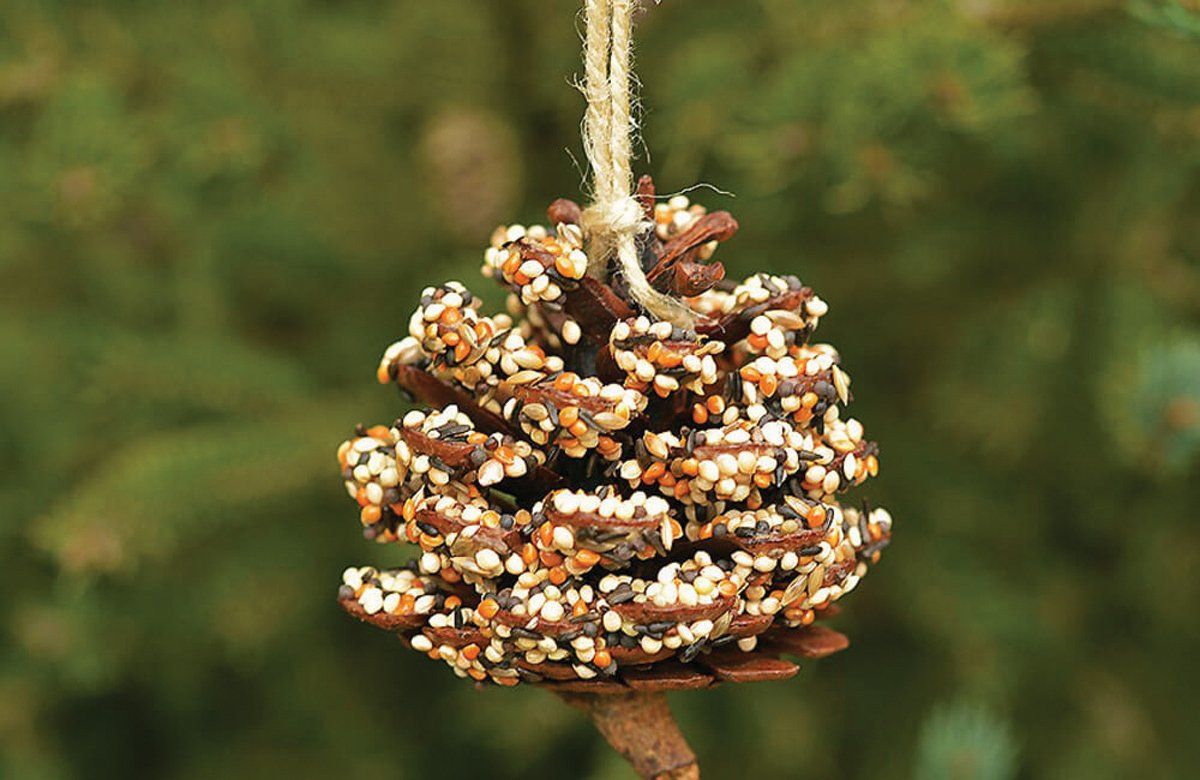A Wild Critter’s Winter Feast
Lending a helping hand to wildlife during the winter
Photos courtesy of Missouri Department of Conservation
Story by Melonie Roberts
When winter weather strikes hard, wildlife can use a helping hand to survive bitter temperatures and loss of natural food sources. Squirrels will generally enjoy chopped apple, grapes, sunflower seeds, hazelnuts, walnuts, chopped carrot or unsweetened rusk.
If The Farmers’ Almanac predictions prove to be accurate, Missouri is in for a bitter cold winter during the 2021-22 season.
One of the easiest and more family-friendly activities for winter afternoons is making pinecone feeders for the birds. Just cover each pinecone scale with a dab of peanut butter and then roll the entire pinecone in a bowl of bird seed. Hanging the loaded cones from tree branches makes feeding time more of a challenge than just bellying up to the bird feeder and gorging on seed.
In fact, the Farmers’ Almanac describes the upcoming winter as “numb’s the word, just shovelin’ along.”
While humans struggle to stay warm in the bitter cold temperatures, wildlife can’t turn up the thermostat or throw an extra log into the wood stove.
“In nature, as is the case with humans, staying warm is a high priority during the cold days of winter,” said Francis Skalicky, media specialist with the Missouri Department of Conservation for the southwest region. “Migration and hibernation are two well-known ways some species deal with winter. However, as evidenced by the abundance of birds and animals that flit, fly and scurry across the landscape throughout winter, some animals have other ways of coping with cold temperatures. Some of the techniques are basic, others are unique, but all are effective. Although we humans always are ready to help, in most cases wildlife needs little – if any – intervention from people to survive the winter.”
For one thing, some animals have fur coats.
“Winter is when a mammal’s fur is thickest,” Skalicky said. “Many mammals shed their summer coats in fall and acquire heavier, thicker fur in winter. Sometimes, this results in slight changes in color over winter. Fur is an excellent insulator and, particularly for larger carnivores such as coyotes and foxes, staying warm isn’t a major issue when a heavy coat of snow has fallen and temperatures have dropped. During these times, finding food can be a bigger problem.
“That’s because the field mice, voles and some of the other smaller mammals that make up part of a carnivore’s diet have retreated to the ‘subnivian zone.’ Subnivian refers to the area under the snow that some small mammals retreat to in winter. Small mammals such as mice and voles will tunnel under the snow down to ground level where seeds, roots, and other vegetative food items are plentiful. In this under-snow world, these creatures continue to stay active. The snow above them acts as comfortable insulation and protective cover from hawks, coyotes and everything roaming above the snow that wants to eat them. For these small creatures, the heavier the snowfall, the better.”
Another tactic many animals use is to eat heavy in autumn. This creates extra fat, which provides bodies with insulation and helps them make it through leaner foraging times of winter.
However, our flying friends face other winter weather challenges.
Carolina Wrens and Eastern Bluebirds are common sights during winter months. Missouri is on the Mississippi flyway, the main route of migratory birds from central Canada in the summer to the Gulf Coast in winter. While especially known for waterfowl and shorebird use, the Mississippi flyway is also a corridor for land birds. Backyard bird feeders can attract a high number of birds, especially in the fall and early winter, providing them the needed calories and carbohydrates to keep warm.
“Birds can’t grow thick fur or tunnel under snow, but they, too, have ways to stay warm,” Skalicky said. “For starters, underneath their exterior feathers, birds have smaller, softer down feathers. These down feathers help to retain heat. Another feather-related issue is moisture. In winter, wet feathers mean a cold body, and one way birds keep water from rain or snow from soaking into their feathers is through preening. Birds have oil-producing glands that allow them, through preening, to apply a coat of water-proofing to their feathers.
“Birds also shiver, which provides heat from circulation and muscle movement,” he said. “Some birds huddle in tight masses when roosting, which is another great way to share body heat and reduce exposure to wind and other elements.”
In winter, birds also take full benefit of south-facing areas for more sun, cedar thickets for less wind, and other cold-avoidance areas provided by the landscape. It also helps that a bird’s feet and the feather-less part of its legs contain very little tissue that can be damaged by cold. Those body parts are mostly bone and sinew.
In spite of all these natural adaptations and characteristics to survive winter, sometimes the weather overrides nature.
“We all remember the extreme cold snap that Missouri experienced last February,” Skalicky said. “This polar vortex was accompanied by a number of reports of backyard birds that had frozen to death. Unfortunately, in the case of these types of weather anomalies, there’s not a lot humans can do.
“In the case of last February’s cold snap, most of the birds that were found frozen were robins, bluebirds, thrushes and other birds that rely on insects and soft mast,” he said. “Birds are amazingly resourceful food-finders and during normal winter conditions, birds can locate spots to get these food items. However, during the conditions we had last February, these birds had no access to the ground to find these food items and, thus, their demise was a combination of starving and freezing to death. Bird feeders that people put up in their yards won’t help these birds in these conditions because they don’t have seed-eating bills and seed-eating habits so these birds don’t come to feeders.”
In conditions of extreme cold and/or extensive ice coverage frozen ground, providing mealworms or cut-up fruit in an area that has no or minimal snow coverage such as a breezeway or on the south side of a building. But, even in these conditions, other birds may eat the food before the birds you’re targeting (robins, bluebirds, and thrushes) can find it.
Cold snaps that occur in late February and March are also hard on early nesting birds such as bluebirds and some species of owls.
“The birds will stay on their eggs until the end and, sadly, in those cases, there’s nothing humans can do,” Skalicky said. “In the cases of all birds that come to feeders in winter, it’s important to provide some type of grit such as ground shells, in these feeders during periods of prolonged ice or snow cover. Birds lack teeth and grit, which is stored in their gizzards, is used to grind up seeds. Normally they get their grit from the ground, but during long periods of snow and ice coverage, birds may find it difficult to find grit on the ground.
“Also be sure to furnish, as best as possible, a supply of unfrozen water,” he said. “Unless you have a heated bird bath, this is going to be challenging during times of prolonged cold, but again, do it as best as possible.”
Some of our four-footed friends can benefit from a little winter weather assistance.
Foods for deer include apples, carrots, and turnips. If trimming tall trees, one can pile up limbs from beech, birch, and wild roses. The deer enjoy eating the bark and leaves. Deer also appreciate hay. Putting out a few flakes now and then provides them with fiber and carbs to get warm. Introducing supplemental foods to deer should take place slowly, over a period of two weeks or more, before making hay and other forage readily available. Feeding locations should be spread over a large area to prevent competition and a concentration of deer in one area.
A coyote's favorite food items include rabbits, mice, voles and shrews. Coyotes will also eat birds, frogs, skunks, berries, insects, occasionally beaver, and carrion, especially road-killed deer. They will avoid humans and attempt to access food unseen if at all possible.
Coyotes typically don’t prey on large animals, preferring instead to consume small mammals, including mice, rabbits, rats, and squirrels. The remainder is fruits, birds, eggs, vegetables, insects, and fish.
Being opportunistic animals, coyotes are scavengers, and will often feed on the carcasses of downed deer. In areas with dense coyote populations, residents may notice them going through their trash cans or snacking on pet food left outdoors.
This behavior means coyotes are often a severe threat to pets. If a coyote views a pet as competition for sustenance, they may attack, which can be fatal. Area residents should always keep small pets safely housed indoors to prevent tragedy.
Area residents should keep in mind that even while lending a helping hand to wildlife, these animals are not domesticated and should not be approached.
For information about conservation issues, call the Missouri Department of Conservation at
417-895-6880.







